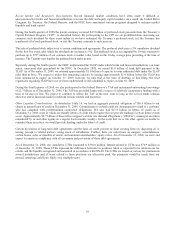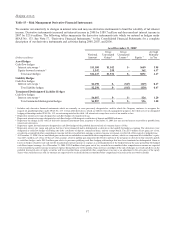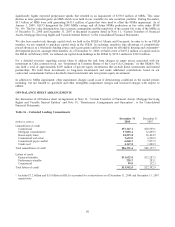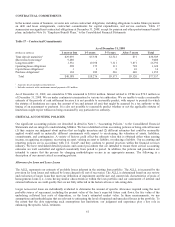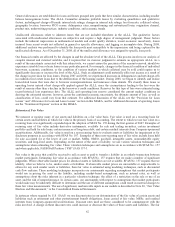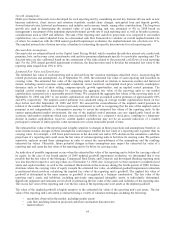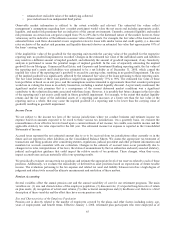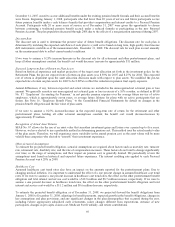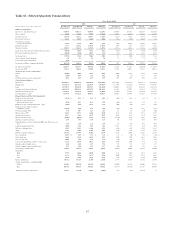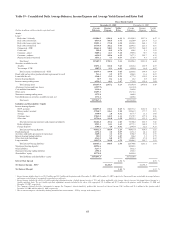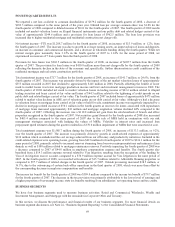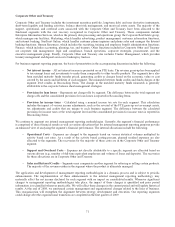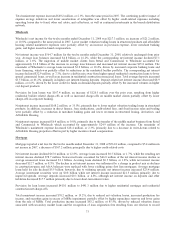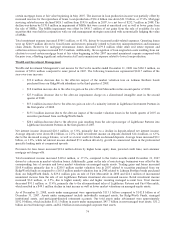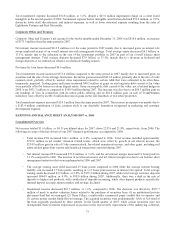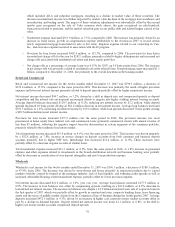SunTrust 2008 Annual Report Download - page 78
Download and view the complete annual report
Please find page 78 of the 2008 SunTrust annual report below. You can navigate through the pages in the report by either clicking on the pages listed below, or by using the keyword search tool below to find specific information within the annual report.December 31, 2007 ceased to accrue additional benefits under the existing pension benefit formula and their accrued benefits
were frozen. Beginning January 1, 2008, participants who had fewer than 20 years of service and future participants accrue
future pension benefits under a cash balance formula that provides compensation and interest credits to a Personal Pension
Account. Participants with 20 or more years of service as of December 31, 2007 were given the opportunity to choose
between continuing a traditional pension benefit accrual under a reduced formula or participating in the new Personal
Pension Account. The plan population decreased through 2008 due to the effects of a reorganization announced during 2007.
Discount Rate
The discount rate is used to determine the present value of future benefit obligations. The discount rate for each plan is
determined by matching the expected cash flows of each plan to a yield curve based on long term, high quality fixed income
debt instruments available as of the measurement date, December 31, 2008. The discount rate for each plan is reset annually
on the measurement date to reflect current market conditions.
If we were to assume a 0.25% increase/decrease in the discount rate for all retirement and other postretirement plans, and
keep all other assumptions constant, the benefit cost would decrease/ increase by approximately $11 million.
Expected Long-term Rate of Return on Plan Assets
Based on historical experience and market projection of the target asset allocation set forth in the investment policy for the
Retirement Plans, the pre-tax expected rate of return on plan assets was 8.50% for 2007 and 8.25% for 2008. This expected
rate of return is dependent upon the asset allocation decisions made with respect to plan assets. We modified the pre-tax
expected rate of return on plan assets for 2009 to be 8.00% to reflect the reduction in pension trust equity exposure.
Annual differences, if any, between expected and actual returns are included in the unrecognized net actuarial gain or loss
amount. We generally amortize any unrecognized net actuarial gain or loss in excess of a 10% corridor, as defined in SFAS
No. 87, “Employers’ Accounting for Pensions,” in net periodic pension expense over the average future service of active
employees, which is approximately seven years, or average future lifetime for plans with no active participants that are
frozen. See Note 16, “Employee Benefit Plans,” to the Consolidated Financial Statements for details on changes in the
pension benefit obligation and the fair value of plan assets.
If we were to assume a 0.25% increase/decrease in the expected long-term rate of return for the retirement and other
postretirement plans, holding all other actuarial assumptions constant, the benefit cost would decrease/increase by
approximately $5 million.
Recognition of Actual Asset Returns
SFAS No. 87 allows for the use of an asset value that smoothes investment gains and losses over a period up to five years.
However, we have elected to use a preferable method in determining pension cost. This method uses the actual market value
of the plan assets. Therefore, we will experience more variability in the annual pension cost, as the asset values will be more
volatile than companies who elected to “smooth” their investment experience.
Other Actuarial Assumptions
To estimate the projected benefit obligation, actuarial assumptions are required about factors such as mortality rate, turnover
rate, retirement rate, disability rate, and the rate of compensation increases. These factors do not tend to change significantly
over time, so the range of assumptions, and their impact on pension cost, is generally limited. We periodically review the
assumptions used based on historical and expected future experience. The interest crediting rate applied to each Personal
Pension Account was 6.28% in 2008.
Healthcare Cost
Assumed healthcare cost trend rates also have an impact on the amounts reported for the postretirement plans. Due to
changing medical inflation, it is important to understand the effect of a one percent change in assumed healthcare cost trend
rates. If we were to assume a one percent increase in healthcare cost trend rates, the effect on the other postretirement benefit
obligation and total interest and service cost would be a $12.8 million and $0.7 million increase, respectively. If we were to
assume a one percent decrease in healthcare trend rates, the effect on the other postretirement benefit obligation and total
interest and service cost would be a $11.2 million and $0.6 million decrease, respectively.
To estimate the projected benefit obligation as of December 31, 2008, we projected forward the benefit obligations from
January 1, 2008 to December 31, 2008, adjusting for benefit payments, expected growth in the benefit obligations, changes in
key assumptions and plan provisions, and any significant changes in the plan demographics that occurred during the year,
including (where appropriate) subsidized early retirements, salary changes different from expectations, entrance of new
participants, changes in per capita claims cost, Medicare Part D subsidy, and retiree contributions.
66


